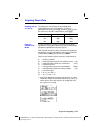
6-6 Sequence Graphing
8306SEQN.DOC TI-83 international English Bob Fedorisko Revised: 02/19/01 12:22 PM Printed: 02/19/01 1:36
PM Page 6 of 16
In a recursive sequence, the
n
th term in the sequence is
defined in relation to the previous term or the term that
precedes the previous term, represented by
u(
n
N
1)
and
u(
n
N
2)
. A recursive sequence may also be defined in
relation to
n
, as in u(
n
)=u(
n
N
1)+
n
.
For example, in the sequence below you cannot calculate
u(5) without first calculating u(1), u(2), u(3), and u(4).
Using an initial value u(
n
Min) = 1, the sequence above
returns
1, 2, 4, 8, 16, . . .
Tip:
On the TI
-
83, you must type each character of the terms. For
example, to enter
u(
n
N
1)
, press
y
[
u
]
£
„
¹
À
¤
.
Recursive sequences require an initial value or values,
since they reference undefined terms.
•
If each term in the sequence is defined in relation to the
previous term, as in
u(
n
N
1)
, you must specify an initial
value for the first term.
•
If each term in the sequence is defined in relation to the
term that precedes the previous term, as in
u(
n
N
2)
, you
must specify initial values for the first two terms. Enter
the initial values as a list enclosed in braces ({ }) with
commas separating the values.
The value of the first term is 0 and the value of the second
term is 1 for the sequence
u(
n
).
Recursive
Sequences


















